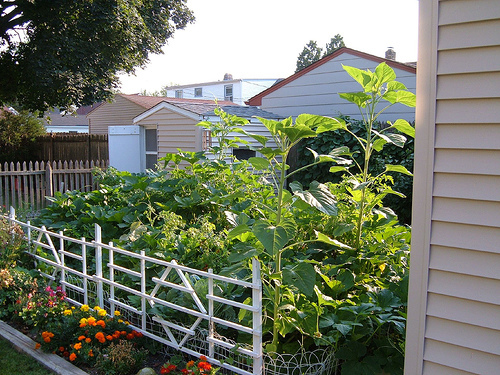
“Sustainable gardening” is a cool term if I’ve ever heard one. It sounds edgy in an incredibly responsible sort of way. In suburban farmer (that would be me) speak it’s: “Do no evil.”
Sustainable gardening is a term that has no technical definition. It’s the concept of using gardening practices that cause no harm to the earth and its inhabitants while attempting to actually enhance it. Words that define “sustain” and “sustenance” are support, preserve, keep alive, maintain, reinforce, and nourishment. These words help paint the picture. By practicing sustainable gardening, you practice good environmental stewardship. Do no evil; that’s it.
Don’t take this to mean that I don’t occasionally break out the pesticidal or fungal frame hammer if need be. But, how often do I really need to? I’ll be honest – not so much. One of my biggest battles is with powdery mildew on roses or vine crops. Roses are the one plant I’ll quietly break out the secret poison stash for once in a while.
One of the reasons that I don’t have to carry around too big of a stick on my suburban farm is because it’s a backyard. Quite frankly, our little gardens very often fly under the radar of the masses as far as pests are concerned. There are a certain couple of weeks in the spring when the aphids converge a bit as well as other interesting (read: infuriating) little plant suckers. But, because we aren’t growing large acreages of crops, the pest number is usually quite small. This doesn’t mean they don’t show up, just that they’re on the easy side to control.
The other reason it’s easy to control pests, (creatures, funguses or otherwise) is due to sustainable gardening. So, how do you do no evil? There are some natural methods that have worked for gardeners and farmers for centuries.
Sustainable Gardening and Farming Practices
- Integrated Pest Management (IPM) – Now, that sounds like a pretty modern term; all scientific, right? Here it is in suburban farmer speak: “Don’t use a bulldozer when a hand trowel will do.” The idea here is starting with the least toxic remedy to a potentially bad situation then moving up in terms of remedies from there. For the most part IPM relies on the gardener or farmer to monitor and gather information. This technique is not only easy – it’s extremely effective.
- Companion Planting – It works like this: a companion plant is used to either confuse or repel plant pests in a garden. The companion plants also serve to attract beneficial insects.
- Beneficial Insects – On occasion, the beneficial insects you’re looking for fail to hear the siren call of the companion plants. In this case, you can actually purchase beneficial so you can release them in your garden. They’re often available at your local nursery, but I’ve found a wider variety through online resources.
- Composting – Using compost in your garden beds or foundation plantings retains moisture in the soil, protects plant roots from temperature fluctuations, has disease-resistant properties, and is a plethora of nutritional value for soil and plants.
If you ask around, you’ll be able to incorporate other ideas such as physical barriers for pests. The point is, it’s simple to practice sustainable gardening and works so well, you’ll wonder how you ever bought into the idea that you need buckets of Roundup and gallons of Miracle-Gro to have a terrific garden in the first place. Plus you get to wear the uber-cool title of “sustainable gardener” to boot.


















Comments
Log in or create an account to post a comment.
Sign up Log in